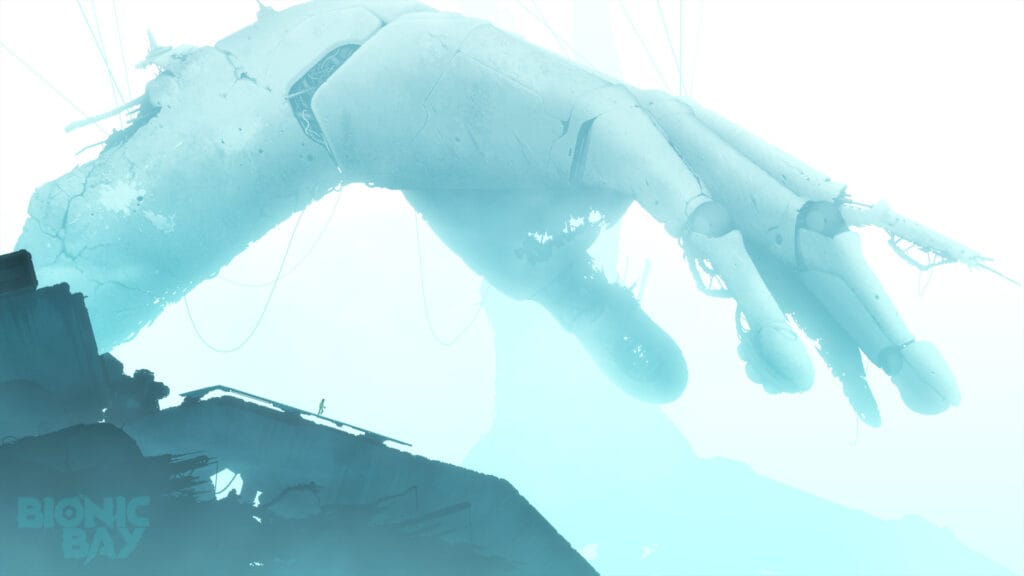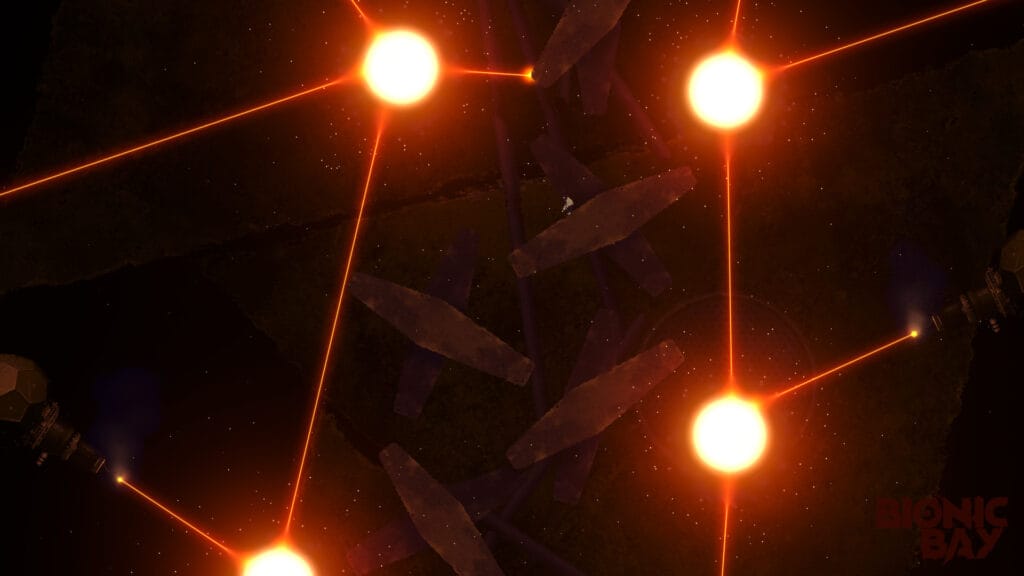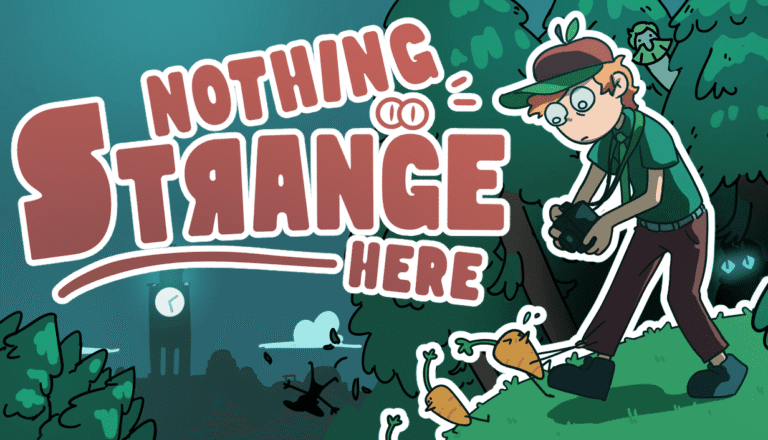There’s a certain kind of madness that comes with playing a game like Bionic Bay. The kind where you look up from your screen, red-eyed and hunched, unsure whether it’s been hours or days. I poured over 20 hours into this game before even starting this review—not because it takes that long to beat, but because it demanded more from me. I restarted puzzles I’d already solved. I explored dead ends just to admire their pixel art. I replayed sections over and over until I could do them without blinking. Writing this review meant missed dinners, bleary-eyed mornings, and putting off other deadlines. And I regret none of it.
I’ve played thousands of games over the years—some for fun, some for work, and some that left an indelible mark on my psyche. Bionic Bay is firmly in the latter category. What started as just another atmospheric indie platformer turned into a philosophical gauntlet disguised as a game. And if you think I’m being overly poetic, it’s only because no other language feels appropriate. Bionic Bay doesn’t just want to challenge your reflexes. It wants to crack open your brain and see what falls out.
It’s Not Just A Platformer: It’s a Revelation
If you judged Bionic Bay by its screenshots, you’d assume it was a cousin of Limbo or Inside—another grayscale fever dream full of death traps and ambiguous storytelling. But that surface-level comparison does a grave disservice to what Psychoflow Studio and Mureena Oy have achieved here. This is not derivative. It’s evolutionary.
The core mechanics are deceptively simple—run, jump, dash, swap. But these are just the entry points into a labyrinth of kinetic complexity. Your movement feels airy, floaty, like someone injected Mario’s double-jump with helium and a hint of LSD. You don’t just traverse; you glide, crash, careen, ricochet. There’s joy in movement here, but it’s the kind of joy you earn with sweat and failure.
And the story? Oh, the story. Or more precisely, the haunting void where a story should be. There are diary entries scattered about, vague environmental cues, and unsettling sci-fi relics littering the landscape. You play as a scientist flung into a dimension that doesn’t obey known physics, let alone logic. But instead of giving you answers, Bionic Bay offers breadcrumbs laced with existential dread.
This world doesn’t want to be explained. It wants to be survived.
A World That Hates You, But Teaches You to Love It
Let me paint a picture: you’re in an abandoned factory, surrounded by the hum of broken machinery. There’s a wall of lasers ahead, a pressure plate somewhere below, and a single crate dangling by a thread. You slap it, teleport into its place midair, and watch in awe as it falls—tripping the switch and opening the path forward. You grin. You breathe. Then a saw blade you didn’t notice slices you in half. You try again.
Bionic Bay is a masterclass in marrying game design with emotional psychology. It wants you to die—not because it’s cruel, but because it knows that pain is the best teacher. There’s a reason the checkpoints are forgiving, the reloads instantaneous. You’re supposed to experiment, to mess up gloriously and often.
The physics-based mechanics—like the ability to swap places with tagged objects, control gravity, or slow time—are just tools. The real puzzle is understanding how to combine them. It’s not about reflexes alone. It’s about ingenuity. And that’s what makes Bionic Bay so much more than a masochistic platformer. It rewards thoughtfulness as much as thumb dexterity.
In fact, some puzzles gave me the same chills I felt solving chambers in Portal. Not because they were similar in mechanics, but because both games trust the player to be clever. And when that trust pays off—when you nail that impossible sequence—you feel invincible.
The Themes Linger—Long After the Game Ends

While Bionic Bay won’t hand-hold you through a plot, its themes are louder than words. Alienation. Futility. The chaos of modern existence. It’s a game about systems—broken ones, beautiful ones, incomprehensible ones. Factories hum and spark with no discernible purpose. Organic growths fuse with machines in grotesque harmony. The message seems to be: this world doesn’t care about you, but that doesn’t mean you can’t carve meaning from it.
In a strange way, it reminded me of reading Blame! or watching Annihilation. You may not understand everything that’s happening, but the tone—oppressive, mysterious, strangely serene—seeps into your bones. And that emotional resonance is more powerful than exposition ever could be.
By the time I reached the end, I wasn’t asking, “What did that all mean?” I was asking, “How did it make me feel?” And that, to me, is a sign of greatness.
Fluid, Fierce, and Fantastically Unforgiving
Let’s get this out of the way—Bionic Bay is hard. But not in a cruel, trollish way. It’s hard like a cryptic crossword or a well-written sonnet: every piece has a purpose, every challenge a solution, if only you can see it.
The game’s control scheme is deceptively basic. You run, you jump, you roll. Then it opens up, and that’s when it hooks you. The first real game-changer is the swap mechanic, allowing you to tag an object and then instantly swap places with it later. This simple idea unleashes a hurricane of design possibilities. You’ll swap through lasers mid-air, tag crates to trigger switches from a distance, or switch places with flying debris to escape death by millisecond margins.
Other powers get layered in—gravity manipulation, slow-motion effects, momentum-based traversal—and each one fundamentally alters how you view the world around you. The developers don’t just add features; they build upon them, evolve them. Every level becomes a masterclass in creative escalation.
You’re not just solving puzzles. You’re dancing with physics, using every ounce of mechanical understanding to navigate what often feels like a beautifully orchestrated Rube Goldberg machine. The platforming is fast but floaty, deliberate yet chaotic. One moment you’re bounding between laser grids like a Jedi gymnast, and the next you’re clumsily pinballing between explosive crates while laughing maniacally. And somehow, it all works.
Despite its complexity, Bionic Bay is never obtuse. It has one of the cleanest difficulty curves I’ve seen in years. New ideas are introduced gently, with visual cues and holographic ghosts showing how a move should look. Then the gloves come off, and you’re left to improvise, internalize, and adapt.
Checkpoints are generous—almost absurdly so at times. But this is a stroke of genius. It removes the sting from failure and instead turns every death into a data point. “Oh, I shouldn’t swap there.” “That timing’s too late.” “Maybe if I jump while rolling…” It fosters experimentation, not frustration.
Even when I died 30 times on a particularly gnarly sequence, I never raged. I wanted to try again. And when I finally pulled it off, I didn’t feel like I’d beaten the game. I felt like I’d earned something.
The level design also deserves special praise. Every screen is like a miniature theater set, carefully choreographed for drama. Some are claustrophobic death traps; others sprawl into open arenas of swinging platforms, gravity fields, and mechanical monstrosities. Each one tells a story through motion and space—an art lost in many modern platformers.
Visual Poetry in Motion: A Pixel Art Triumph

Let me say this bluntly: Bionic Bay is one of the most gorgeous pixel art games I’ve ever played. Yes, I’m including Dead Cells, Hyper Light Drifter, and Octopath Traveler. Where those games dazzle with color or polish, Bionic Bay stuns with its atmosphere.
Every level is dripping in detail, rendered in crisp pixel precision, but always layered with stylistic intent. Silhouettes blend with brutalist architecture. Backdrops bloom with alien bioluminescence or techno-organic horror. At times, I paused mid-level just to take it all in—the floating brains, the glass-walled biolabs, the crimson floodlights illuminating twisted pipe mazes. It’s mesmerizing.
And the visual language isn’t just decorative—it’s functional. Shadows guide you toward safe zones. Color gradients warn of danger. Every moving part, from explosive crates to conveyor belts, stands out clearly against its backdrop. It’s design that understands both form and function, like Hollow Knight with a post-industrial edge.
Even your character—the floppy, ragdoll-esque scientist—adds to the visual comedy and horror. Their exaggerated animations, the way they slump after a long fall or flail mid-swap, inject levity into an otherwise brutal world. You die a lot, yes—but you die beautifully.
A Soundscape from Another World
To say the sound design in Bionic Bay is good would be a crime of understatement. This game doesn’t just sound good—it feels like it was composed inside a broken spaceship humming with alien life.
The score leans ambient, layering low rumbles, glitchy motifs, and haunting synths over key moments. It knows when to whisper and when to roar. In some areas, the music disappears entirely, replaced by the hiss of vents or the far-off screech of failing machinery. It’s immersive, unsettling, and perfect.
And when the music does swell—when the piano kicks in mid-puzzle, or a synth warble rises during an epic jump sequence—it hits like a freight train of emotion. These moments reminded me of Celeste, where the music isn’t just background noise but an emotional amplifier. You feel every success more intensely because the sound is in perfect sync with your triumph.
Sound effects also deserve a shout-out. The weighty “clunk” of a crate slamming onto a pressure plate. The electric crackle of a laser grid activating. The soft ping of a checkpoint. It all builds a world that feels mechanical and alive, like you’re running through a living organism made of steel.
Technical Brilliance in a World Gone Mad
Despite its complexity, Bionic Bay runs like a dream. On PC, I experienced smooth frame rates, quick load times, and not a single crash across dozens of hours. For a game that relies so heavily on real-time physics and split-second precision, that level of stability is a godsend.
The UI is sleek, minimalist, and highly responsive. Every control feels tuned to perfection. And the inclusion of in-game tutorials, holographic demos, and customizable input mapping shows how deeply the developers understand player experience. Even the pause menu lets you test control changes before committing—a small detail, but one that speaks volumes.
And it’s not just about performance. It’s about polish. The way shadows flicker as you slide past molten pipes. The smoothness of object swapping. The ragdoll physics that manage to be hilarious, tragic, and functional all at once. It’s the kind of attention to detail you rarely see, especially in indie games.
The Few Flaws in the Machine
No game is perfect, and Bionic Bay isn’t above critique. The story, or lack thereof, may disappoint players who crave narrative closure. While the atmosphere is potent and the world rich in mystery, some may find its ambiguity frustrating rather than intriguing.
There are also occasional moments where the physics engine can feel too unpredictable. A box might bounce slightly differently on one attempt than another, costing you a perfectly timed swap or killing your momentum. It’s rare, but noticeable.
And for all its accessibility features, this is still a hard game. Players looking for a breezy platformer might find themselves overwhelmed. While checkpoints soften the blow, the steep learning curve and relentless design might not be for everyone.
But none of these issues detract from the game’s brilliance. They’re quirks of a daring, complex system—edges left deliberately unpolished to preserve the wild heart of the experience.
So here’s my plea to you, dear reader: Don’t write off Bionic Bay because it looks hard. Don’t skip it because it’s another pixel-art indie game. This isn’t just a game. It’s an experience. A challenge. A revelation.
Play it not just for the puzzles or the visuals or the physics wizardry. Play it because it will make you feel—rage, joy, awe, confusion, triumph. Play it because it respects you as a player. Because it dares to push the genre forward in bold, brilliant ways.
If you’re tired of games that play it safe, if you want something that will stick with you long after the credits roll, then Bionic Bay is calling. Answer it.
A Modern Platforming Masterpiece That Dares You to Think and Feel
Bionic Bay is not just a standout platformer in 2025—it’s a defining moment for the genre. It takes everything we love about classics like Celeste, Inside, and Portal, then shatters expectations with a uniquely physics-driven, mind-bending twist. It’s an uncompromising work of art that balances complexity with clarity, brutality with beauty, and challenge with charm.
Yes, it’s demanding. Yes, it can be frustrating. But never unfair. Never hollow. Everything it throws at you is purposeful. Every failure leads to insight. Every success feels earned. And in a world overrun with handholding and spectacle, Bionic Bay dares to trust the player.
I walked into this game expecting clever puzzles and pretty art. I walked away feeling like I’d just survived something deeper—something stranger, smarter, and more human than I ever anticipated. This is not just one of the best indie platformers in recent memory. It’s one of the best games of the year.
If you’ve ever loved a platformer, if you’ve ever wanted a game to challenge your intellect as much as your reflexes—Bionic Bay is a must-play.

Pros & Cons
Pros:
- Genius puzzle-platforming mechanics built on intuitive yet endlessly complex physics.
- Breathtaking pixel art and striking visual design that enhance atmosphere and gameplay.
- Incredible sound design and ambient score, creating a deeply immersive world.
- Fluid, responsive controls with a generous checkpoint system for a fair challenge.
- Unique powers and abilities that constantly evolve the gameplay in meaningful ways.
- Thoughtful level design that rewards experimentation, timing, and intellect.
- Surprising emotional depth through minimalistic yet potent storytelling.
- Perfect for speedrunners, with mechanics tailored for route optimization.
- Optimized technical performance, even on handheld systems like Steam Deck.
Cons:
- Sparse narrative may leave some players craving more explicit storytelling.
- Occasional unpredictability in physics interactions can disrupt flow.
- High difficulty ceiling could alienate casual or impatient players.
- A few repetitive visual elements in the mid-game environments.
⭐Final Score: 4.5 / 5⭐
A brilliant, brutal, and beautiful platformer that redefines the genre with intelligence, style, and soul.
The game was reviewed on PC and a Review Code was provided by Publisher for review.


